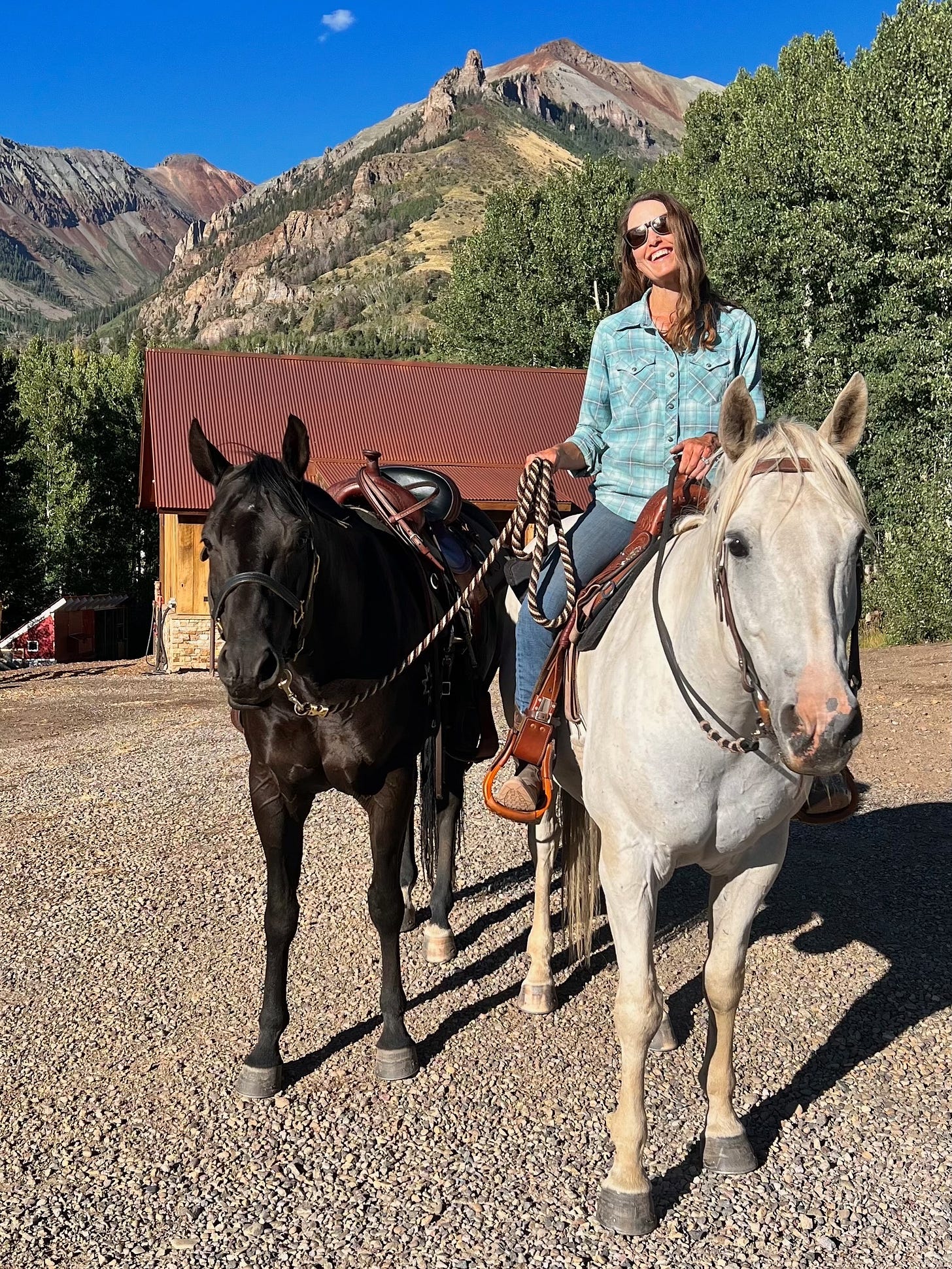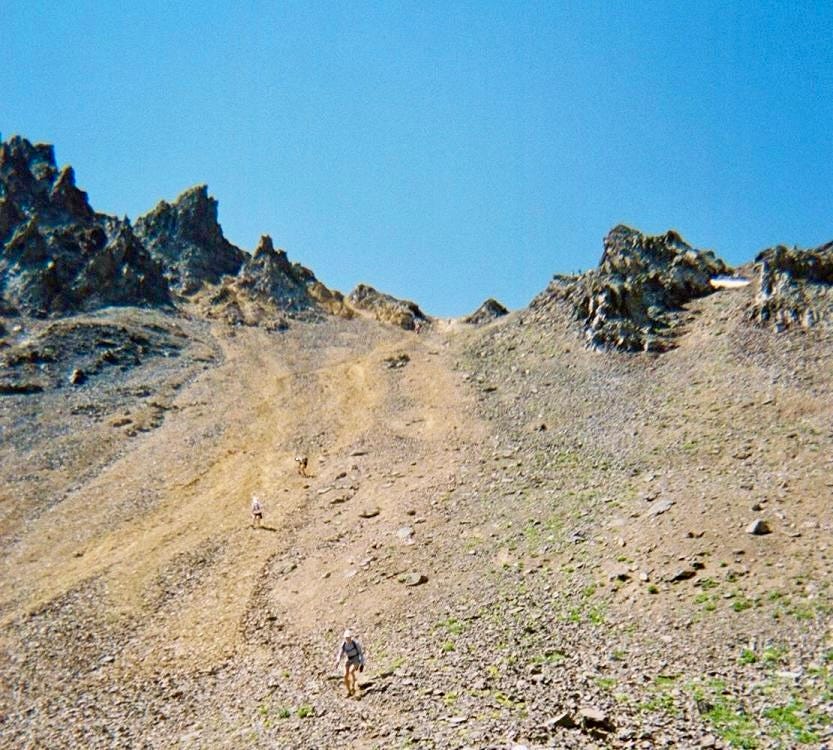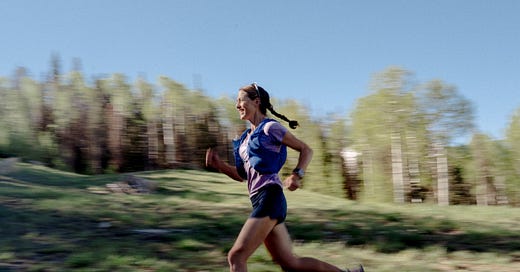Heading for Hardrock: The 10-year making of a dream
How 100 mountain miles became destiny for Sarah Lavender Smith
There isn’t much Sarah Lavender Smith hasn’t done in the world of running.
The Colorado resident has run more than 100 ultras and marathons, winning several at the 50k distance and clocking up many thousands of miles during more than 30 years in the sport.
In 2019, she won the Grand to Grand Ultra, widely celebrated as one of the toughest races in the world.
Eight years spent coaching spawned a book, The Trail Runner’s Companion, while her journalism has seen her regularly featured in publications such as Trail Runner, Telluride Magazine and UltraRunning magazine - as well as her hugely popular Mountain Running & Living Substack blog.
Add in time spent volunteering at aid stations and pacing other runners, and you might be forgiven for thinking there’s not much left for the 55-year-old to achieve.
But Sarah has a ten year itch she needs to scratch: an event as hard to get into as it is to run.
It is a race which features 102.5 miles (165km) and 33,000 feet (10,000 m) of climb through an area of such spiritual significance to her that she can track her family roots there back to 1880.
Sarah’s date with destiny will arrive on July 11, 2025 in Silverton, Colorado.
At 6am on that day, she will toe the start line of one of ultra running’s most famous races: The Hardrock 100.
‘Satisfaction , ego-gratification and community’ - finding a love of running:

There was a time, more than three decades ago, when sport - let alone running - hadn’t been on Sarah’s agenda.
She told Running Tales she wasn’t sporty growing up and only started to run in 1994 as a way of combating the stress of graduate school.
Inspired by a couple of friends who had run a marathon, Sarah used the sport as a way to counter body image concerns that arose out of her childhood.
“I'm halfway through drafting my memoir right now, and a lot it will be about what compels me to keep running,” she said.
“And it stems from a childhood and adolescence that did not make me feel great about my body and did not make me treat my body well.”
She completed her first marathon that same year and running quickly became an essential part of Sarah’s life, accompanying her into marriage and motherhood.
The sport provided her with “satisfaction and ego-gratification and community that I wasn't getting in my part-time career or at home”.
After spending her early running years competing in road races, Sarah slowly transitioned to trail and ultra runs - events she has been favouring for the past two decades.
Originally, it was the 50km distance she preferred - and found success in.
“I was competitive in terms of podium finishes and had some wins when I first transitioned to the trails over 50k,” she said.
“That was in the mid- to late-2000s, when I was in my late 30s, and there were fewer women in the sport.
“But I did win my first 50k, back in 2007 I believe. And I did have early success, which was really exciting.”
Finding success and serenity at Grand to Grand:

Sarah’s progression to 100-milers was gradual, her first race at that distance coming in 2014.
“I spent a lot of time at the 50k and 50 mile distances,” she said.
“I started running 100-milers and 24-hour events, then I did a handful of mountain ultras as opposed to the coastal ones in California at low altitude.”
Since then, she has competed in some of the hardest ultras around, including the Wasatch Front 100 in Utah, and Colorado‘s Run Rabbit Run and High Lonesome.
But the event that really shaped her was the Grand to Grand Ultra, a seven-day self-supported race covering 275km (171 miles) through Arizona and Utah.
Modelled on the Marathon des Sables, the Grand to Grand runs through the harsh desert environment of the Grand Canyon and is considered by many to be tougher than its Sahara rival.
Sarah told Running Tales there was something about the challenge of an off-grid, self-supported race that spoke to her and “helped me find myself”.
Her first attempt at it came in the 2012 inaugural event via an assignment from her editor at Trail Runner magazine. She surprised everyone by finishing as third woman and seventh overall.
In all, Sarah has taken part in Grand to Grand four times, including last September, and in 2019 she finished as first lady and tenth overall.
It is an event she said has brought her “intense thinking time” and given her the ability to tackle everyday issues head-on.
“It's really like a wilderness retreat,” she added. “People have gone on spirit quests since the dawn of time.
“For me, there was the aspect of the spirit quest because you are completely disconnected from your devices for a week.
“You are spread out, mostly by yourself during the day, until you regroup with your fellow competitors at camp at night.
“And everything you need has to be on your back. If you get hungry, if a piece of gear breaks, you have to adapt and figure it out.
“I've had moments where I've transcended hunger or pain or problems in a way that I didn't know I could until I did it.
“When I get back home, I know that in daily life I can handle tricky, difficult situations or difficult people because I know what I've done.
“Maybe people underestimate me in some ways because they don't know what I've been through out there.
“I come across as a pretty average, affluent, white, middle-aged, midlife woman who seems pretty normal.
“People who don't know my runner side maybe are surprised when they hear that I run hundred hundreds of miles through the desert.”
Growing community on Substack - Mountain Running & Living:

Sarah’s Hardrock preparation and running ups and downs are chronicled in her popular Mountain Running & Living Substack newsletter.
With close to 4,000 subscribers, the blog features far more than simply a list of running achievements or race reports, with Sarah chronicling her life in Talluride, giving training advice, and writing openly of her concerns as a runner on the wrong side of 50.
The newsletter grew out of her decade old blog, TheRunnersTrip.com, before moving to Substack in 2021.
“Substack has challenged me to be consistent with a weekly newsletter and to really build community through it,” Sarah said.
“I feel I'm trying to give a voice to midlife runners and to anyone who's interested in leading a more rural and outdoorsy life.
“And, also, I write about being an empty nester. My two children are now in their mid-twenties. So, I have adult children and that's a big life change - a new chapter in my life that I write about.”
The ‘romanticised’ race in the backyard of the San Juan Mountains:

And so, to Hardrock - a 102.5 miles (165km) race, which features 33,000 feet (10,000 m) of climb at an average elevation of over 11,000 feet (3,400m).
Taking place in Southern Colorado’s San Juan Range, the event is considered one of the hardest around.
Because of its tough nature, qualification for Hardrock is an endurance event in itself. Less than 150 people ran it in 2024, with even fewer being first-timers.
Those eligible to apply must have completed one of only 33 qualifying races - known as a ‘burley’ - within the two years prior to their application.
Then there is the service requirement element of entering, which dictates potential runners must complete at least eight hours of voluntary work. This includes helping to organise an ultra, working at an aid station, or doing formal maintenance work on a trail.
Runners who hit those targets are then entered into a lottery, where there is a demand for gender proportionality and categories for racers who have both previously finished and those who haven’t done so. It’s just the start of a convoluted process that involves potential entrants earning numerous application tickets to boost their chances.
Sarah was first told about Hardrock in the early 2000s and she initially played a part in the event as a pacer back in 2011.
She said: “I always knew about it because the race takes place in my extended backyard here in the San Juan Mountains.
“And the route is very special to me because I grew up learning about these mountains in the back of my dad's truck. He was really into four-wheel driving over old mining roads, so as a kid I was exposed to these mountains.
“I've always been very interested in and have romanticised my ancestors who worked in the mountains.
“My grandfather, his brother, and my grandmother, who I never met because she died before I was born, they were all incredible mountain climbers here in the 1920s and early-1930s.
“I've always wanted to learn more about them and follow in their footsteps. Hardrock spoke of putting me in closer touch with my ancestors' legacy and the mountain heritage.”
That love of nature and the outdoors is something which has always shaped Sarah’s running.
Initially, as a graduate student at Berkeley, she learnt to run in the beautiful coastal hills around the San Francisco Bay Area, but the incredible surroundings of Telluride, Colorado and the San Juan Mountains have provided the backdrop to much of her running - and life.
“I spent every summer of my childhood here, and then my parents and my brother moved here,” she said.
“And so my husband and I left California and moved here and built a home in 2016.
“I live at 9,000 feet. We’re in a rural area with wildlife and I'm looking out the window at a 12,000 foot peak, and there's a 14,000 foot peak over there.
“I'm very grateful.”
The appeal of Hardrock is obvious, but for a long time Sarah didn’t even have the confidence to apply for the race.
Her 2011 pacer appearance saw her run the last 30 miles of the event, from Telluride to Silverton - an experience she described as being both “mind-blowing but also dangerous”.
At that stage she didn’t feel capable of tackling the full race, but as time went by she started to take on the qualifying races required and in 2015 entered the lottery for the first time.
It’s a process she’s dedicated herself to every year since, ticking off qualifiers, running as a pacer and volunteering at the event’s aid stations.
Sarah has put her name in the lottery every year since, with the exception of 2019 and 2020, when firstly the threat of avalanche and then the pandemic meant Hardrock was cancelled.
Those experiences, along with giving history talks at Camp Hardrock in the week before the event, earned her more and more lottery tickets.
Even then, success in the draw was not certain with 19 spots available in her pool of ‘female nevers’ and more than 600 women gunning for them.
But finally, 10 years on from that first application, the process has been conquered leaving Sarah on a collision course with Hardrock destiny.
“I'm doing everything I can to make it successful,” she said.
“It’s hard because I'm coming out of injury. So, I'm rebuilding fitness. I was injured for three whole months starting in early November. I couldn't run.
“I needed special treatment, and so I didn't really start training again until early February. I really have my work cut out for me.
“But I also recognise that with Hardrock, I am a mid- to back of the packer given my age and my slowness.
“I really just need to prevent problems and troubleshoot. It's funny, I have confidence in my physical fitness or at least in the fitness I will have by July.
“And so I really am zeroing in on the things that can go wrong that are preventable, such as getting hypothermia, becoming nauseous or having my lungs get overstressed.
“It's really just preventing the problems and blow-ups.”
Battling age, menopause and altitude:
The “slowness” Sarah talks about is something she references regularly in her Mountain Running & Living newsletter, a relative term largely applied to compare her current pace to the one she used to run at.
She uses the blog to examine how age and the menopause have affected her running, but also to celebrate those runners in their 50s and 60s who are still achieving incredible things.
Sarah said since turning 50 - the age at which she won Grand to Grand - she has “slowed down significantly,” blaming aging, the menopause and the effects of living and training at high altitude.
“I used to live only half the year here, and then I still lived half the year in California,” she said.
“But transitioning to full-time living in the high altitude, where slow running with hiking breaks is normalised, it slows you down.
“People who know me from California say, ‘oh, you must be so fast when you come back to the coastline because your altitude adapted’ and I say no.
“The opposite is true because I have normalised a five mile per hour or twelve minute per mile pace because there's so much hiking involved in these mountains. Sometimes it's only four miles an hour or fifteen minutes per mile.
“Whereas, when I was a marathon runner in California, my marathon pace was in the seven minute range. I'd finish between three to three-and-a-half hours in the marathon. That was normal for me. Now I can't fathom running that fast.
“I can't even run my old marathon pace for a mile. That’s extremely humbling and I've really had to make peace with just being a steady tortoise, focusing on endurance and just feeling gratitude for still getting out there.
“I'm not fast anymore, so I just try to be efficient. But it's very hard mentally, and that's why I like having older role models, both male and female, who have gone through the same thing in their 50s and are still keeping it up in their 60s.”
Sarah said her current struggles make her more determined to push herself by running hard and fast when she can.
“I want to challenge myself to be a real runner and finish with good cadence and push my heart rate,” she said.
“I'm coming back from injury, so I have to remind myself how to run with good cadence.
“I have to put in some speed work once a week, not to be fast per se, but just to rebuild my cardio engine.
“That never goes away in terms of importance. Even when you're slow, you should still try to run fast at least once a week.”
Fast or slow, one thing is certain: There are still plenty of miles left in Sarah Lavender Smith - starting with that date with destiny at the Hardrock 100.
Support Running Tales:
Please help us keep producing Running Tales across Substack and in podcast form:





Thank you, Craig, for sharing my story! If anyone is interested in or has questions about the Grand to Grand Ultra or Hardrock, hit me up.